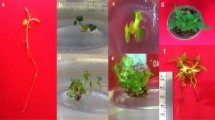Abstract
Cotyledon explants of Panax ginseng produced somatic embryos directly on solid hormone-free MS medium containing 3% (w/v) sucrose while high concentration of NH4NO3 (60 mM) induced embryogenic callus. Ten subcultures of the embryogenic callus on hormone-free MS medium with 40 mM NH4NO3 gave hormone-independent proliferation of callus, which exhibited proliferation potential even on MS medium with a standard level of NH4NO3 (20 mM). Pulse treatment of callus with exogenous auxin or cytokinin (1.0 mg 1−1 2,4-D, 1.0 mg 1−1 kinetin) resulted in the loss of the hormone-independent characteristic and caused the callus to brown. For the suspension culture, embryogenic callus was transferred to MS liquid medium containing 3% (w/v) sucrose in an 500 ml Erlenmyer flask. Embryogenic cell clumps in full-strength MS liquid medium discharged toxic substances, resulting in strong suppression of cell growth. In 1/3-strength MS medium, exudation of toxic material did not occur. Embryogenic cell clumps were mass-grown on a large-scale in a bioreactor (20-1), showing a 7.1 increase of fresh weight in 1/3-strength MS medium with 3% (w/ v) sucrose after 5 weeks of culture. Total ginsenoside content of cultured embryogenic cell clumps was low and 6 times below naturally-cultivated ginseng roots.
Similar content being viewed by others
References
Ando T, Tanaka O & Shibata S (1971) Chemical studies on the oriential plant drugs.XXV. Comparative studies on the saponins and sapogenins of ginseng and related crude drugs. Syoyakugaku Zasshi 25: 28-32
Asaka I, Li I, Yoshikawa T, Hirotani M & Furuya T (1993a). Embryoid formation by high temperature treatment from multiple shoots of Panax ginseng Planta Med. 59: 345-346
Asaka I, Li I, Hirotani M, Asada Y & Furuya T (1993b) Production of ginsenoside saponins by culturing ginseng (Panax ginseng) embryogenic tissues in bioreactors. Biotech. Lett. 15: 1259-1264
Chang WC & Hsing YI (1980) In vitro flowering of embryoids derived from mature root callus of ginseng (Panax ginseng). Nature 284: 341-342
Choi SM, Son SH, Kwon OW, Seon JH & Paek KY (2000) Pilot-scale culture of adventitious roots of ginseng in a bioreactor system. Plant Cell Tiss. Org. Cult. 62: 187-193
Choi YE, Yang DC, Yoon ES & Choi KT (1999) High efficiency plant production via direct somatic single embryogenesis from pre-plasmolysed cotyledons of Panax ginseng and possible dormancy of somatic embryos. Plant Cell Rep. 18: 493-499
Choi YE, Yang DC, Park JC, Soh WY & Choi KT (1998) Re-generative ability of somatic single and multiple embryos from cotyledons of Korean ginseng on hormone-free medium. Plant Cell Rep. 17: 544-551
Flowers TJ, Troke PF & Yeo AR (1977) The mechanism of salt tolerance in halophytes. Ann. Rev. Plant Physiol. 28: 89-121
Furuya T, Yoshikawa T, Ishii T & Kajii K (1983) Effects of auxins on growth and saponin production in callus cultures of Panax ginseng. Plant. Med. 47: 183-187
Lu M, Wong HL & Teng HL (2001) Effects of elicitation on the production of saponin in cell culture of Panax ginseng. Plant Cell Rep. 20: 674-677
Madrigal-Bujaidar E, Hernandez-Ceruelos A & Chamorro G (2001) Induction of sister chromatid exchanges by 2,4-dichloro-phenoxyacetic acid in somatic and germ cells of mice exposed in vivo. Food Chem. Toxicol. 39: 941-946
Murashige T & Skoog F (1962) A revised medium for rapid growth and bioassays with tobacco tissue. Physiol. Plant. 15: 473-497
Son SH, Choi SM, Lee YH, Choi KB, Yun SR, Kim JK, Park HJ, Kwon OW, Noh EW, Seon JH & Park YG (2000) Large-scale growth and taxane production in cell cultures of Taxus cuspidata (Japanese yew) using a novel bioreactor. Plant Cell Rep. 19: 628-633
Willemsen RE & Hailey A. (2001) Effects of spraying the herbicides 2,4-D and 2,4,5-T on a population of the tortoise Testudo hermanni in southern Greece. Environ. Pollut. 113: 71-78
Yoshikawa T & Furuya T (1987) Saponin production by cultures of Panax ginseng transformed with Agrobacterium rhizogenes. Plant Cell Rep. 6: 449-453
Zhong JJ, Bai Y & Wang DJ (1996) Effect of plant growth regulators on cell growth and ginsenoside saponin production by suspension cultures of Panax quinquefolium. J. Biotech. 45: 227-234
Author information
Authors and Affiliations
Corresponding author
Rights and permissions
About this article
Cite this article
Choi, Y., Jeong, J. & Shin, C. Hormone-independent embryogenic callus production from ginseng cotyledons using high concentrations of NH4NO3 and progress towards bioreactor production. Plant Cell, Tissue and Organ Culture 72, 229–235 (2003). https://doi.org/10.1023/A:1022319122522
Issue Date:
DOI: https://doi.org/10.1023/A:1022319122522




